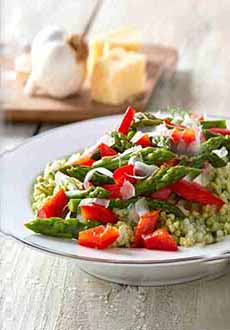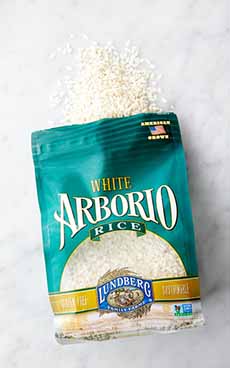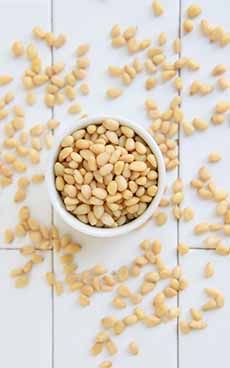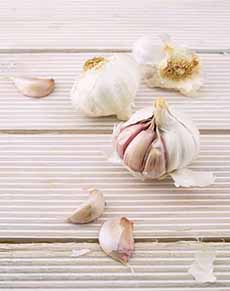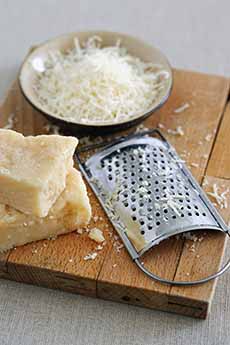Easy Christmas Risotto Recipe & The Types Of Risotto Rice
|
Most of us would not consider risotto to be an “easy” recipe. It requires constant observation and stirring. But Dole created this recipe as a multi-cooker risotto. The rice practically makes itself! And the bright holiday colors have great eye appeal in what is often a “beige” dish. The recipe follows below, but first: > The different types of rice: a photo glossary. There are links to more risotto recipes below. > There is no Risotto Day, but September is National Rice Month. A bit of history: The first evidence of rice cultivation in Italy dates to 1468 in Florence. In the late 1400s rice cultivation spread to northern Italy, to Lombardy and Piedmont. An advantage there was the Po Valley, a flat and fertile plain that is watered by the Po River and its tributaries. Frequent flooding of the Po River enabled the rice to be grown in paddies. The Po Valley is an ideal environment for rice cultivation [source]. From those beginnings, many types of rice were bred and cultivated. On to risotto. To create the signature creaminess of risotto, the type of rice used must contain a just-right amount of starch to create its creamy texture and sauce. The creaminess is the result of slowly coaxing the starch out of the rice as it is cooked and stirred every 30 seconds or so for 20 to 30 minutes. The rices tend to be Japonica cultivars, from the same genus that produces the other “sticky rices,” including mochi, sushi, and sweet rice varieties. Italy grows four main varieties of superfino rice (the highest grade of Italian rice) for risotto: Arborio, Baldo, Carnaroli, and Vialone Nano. These differ in length and vary slightly in starch content and texture. Usually chefs have a particular preference, and there are regional preferences as well, e.g. for a drier versus a soupier risotto. You can experiment to see which type you like best. The following four rice varieties are grown in Northern Italy’s Po Valley, which stretches across several regions including Emilia-Romagna, Lombardy, Piedmont, and Veneto. Arborio rice develops a creamy texture around a chewy center and has exceptional ability to absorb flavors. Arborio is more widely available and less expensive, but it’s not as starchy as Baldo, Carnaroli, or Vialone Nano and thus absorbs the broth liquid—which provides the creaminess—a little less well. Still, its availability and price make it the most popular rice for making risotto. It produces a relatively creamy risotto with a hearty texture. Baldo has medium-sized grains that are slightly longer and more slender than those of Arborio rice. The grains are not as round as Vialone Nano and maintain their texture during cooking The rice has a rich flavor and typically requires a shorter cooking time compared to some other rice varieties. The variety was named after Professor Emiliano Carnaroli, President of the Ente Nazionale Risi (National Rice Body) at that time. Carnaroli is a plumper, larger grain of rice that’s preferred by many chefs for producing a very creamy risotto with a nice bite. Highly prized, it is the most widely used rice in overall Italian cuisine [source]. The grains are thick and stubby in comparison to other types of superfino rice, with a wide central core known as the “pearl.” The variety is named “Nano” because of its small size. It’s widely considered the archetype of the Italian risotto rice [source]. It’s the risotto rice of choice in the Veneto region of Northern Italy, particularly around Verona. Vialone Nano absorbs liquid well and is commonly used for soupy-style risottos, especially those with added seafood. Compared to other three varieties, it’s considered to absorb flavors more effectively while retaining a firm, al dente, texture. It cooks relatively quickly while still releasing enough starch to create a creamy dish [source]. Prep time is 20 Minutes, cook time is 10 minutes. Preparation 1. PURÉE the garlic, broccoli, spinach, pine nuts, lemon juice, parmesan cheese, 3 tablespoons oil, lemon zest, salt, black pepper and 1/3 cup water in a food processor (makes about 1¾ cups). 2. COOK the asparagus, bell peppers and remaining 1 tablespoon oil in a multi-cooker on sauté setting 5 minutes or until the vegetables are tender, stirring occasionally. Transfer to a plate with a slotted spoon (makes about 4 cups). 3. ADD the rice to the multi-cooker; cook for 3 minutes or until toasted, stirring occasionally. 4. STIR in 4 cups of hot water; cover, seal vent and cook for 2 minutes on high pressure. Quick release the pressure and remove the lid; stir in the pesto (makes about 7 cups). 5. SERVE the risotto topped with the asparagus and peppers. Garnish with cheese before serving, or pass the extra Parmesan cheese in a bowl or ramekin so people can add their own. Also pass a pepper mill so they can add fresh pepper to taste. |
|
|
|
|
||
